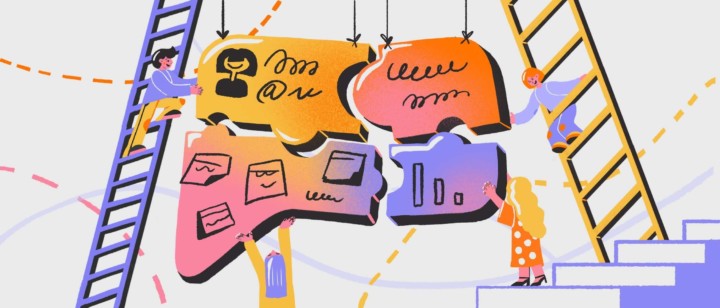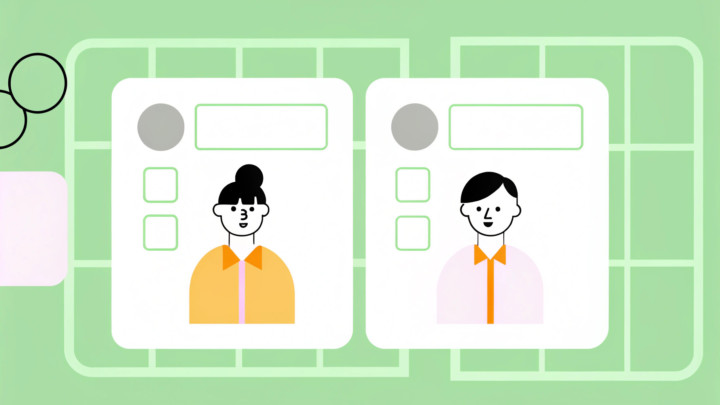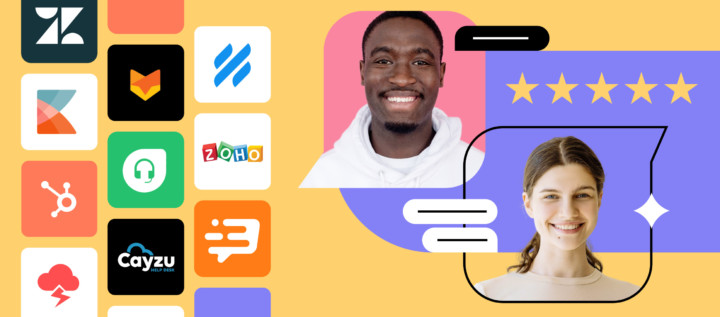What are the customers in B2B SaaS and how to deal with them

This is an article about what types of customers are most common in B2B SaaS and how to build engagement with them. However, this is also a declaration of love for our customers?
We talked to people from the Dashly sales, implementation and support teams who most often communicate with our customers and asked them to tell us about them: what they are, why they love us and we love them, what can annoy them in us and what can annoy us in them, but how we make each other better year after year.
First, let’s figure out how your marketing should handle customers 👇
Now we’re moving on to other teams.
Customer types at the sales stage
A million articles and memos have been written about how salespeople classify customers. We’ll tell you how our guys do it.
First of all, customers are divided into the target and non-target ones.
Target customers

What does a “target customer” mean?
It’s not about the size of the company/traffic volume or the amount of money they can generate. It’s about whether or not you will do them any good
Roman Cobb, Dashly sales team
Will there be a win-win situation with them when the service really brings benefits to their business, and they are ready to stay with you for a long time?
How do you know that the customer is the target one?
You should always try to get to the bottom of the issue that brought the customer to you. And also you need to understand if they have the resources or motivation to effectively use your service.
You need to define a “job”
The “job” for which the customer wants to hire you is determined according to the JTBD theory. Your tool can be too sophisticated and unsuitable for their business. Or, alternatively, it will only partially solve their issue. And if you’re aware of that, you have to be honest and straightforward about it.
You need to assess the customer’s motivation
If you have a sophisticated product, you can offer the customer the implementation service. For example, we help our customers gather data and set up their first campaigns. But it will only be mutually beneficial if the customer is ready to get actively involved in the process at this stage and then continue using the service on their own. Perhaps with a little help from your support team.
If the customer is interested and ready to learn, there is every chance to get the win-win outcome. In general, customers who are motivated to learn and develop are among the best. All content marketing and many other things are done for such customers: blogs, training articles, and videos, knowledge bases, etc. are created and maintained. The implementation and support teams are happy to work with such customers.
Non-target customers
There are several types of non-target customers.
Among them, those who agree to everything quickly and without going into the essence of the proposal stand out. Such customers, in turn, are divided into two more categories.
Bustlers
“Yes, yes, yes, I want it right now, I want it!”

They immediately say “yes” no matter what you say. They’re in a hurry, they don’t get into your words. They’re not as simple as they look at first sight.
How to deal with them?
You need to make sure they understand what they’re saying “yes” to.
When a customer is in a hurry and says “yes” to everything, you definitely have to align with them
Roman Cobb, Dashly sales team
Explain in detail what the tool can do, which tasks it can solve and which it cannot.
What can happen if you don’t do so?
If you immediately close the sale in 5 minutes (we’ve been there), a customer who did not fully understand the tool may experience disappointment. And along with them, your team as well. Because you were hoping that if they bought from you so quickly, it would mean that now they are with you forever.
Polite, but not ready to solve their issue themselves
“Yes, yes, sure! And what are you talking about?”

Others say “yes” just so you don’t get hurt. And they may not even know what you’re talking about. They have an issue related to your sphere, but they don’t even know how to approach it. They expect you to give them a magic pill so that they don’t have to think about it anymore.
Why is that bad?
Their expectations are likely to be inflated. Such customers do not fully understand what tool they need at the moment and for what specific tasks. Let’s say, they have an abstract task of developing their marketing, but at the same time, there is no systematic insight into how marketing communications are organized in essence.
How to deal with them?
In this case, there is no need to immediately sell them the product at any cost. Guide them through another funnel. They should be gradually taught through content marketing. If you do everything right, they will get back to you, but already being your target customers.
Make sure the customer is a target one:
1. They understand what the service does and know exactly what tasks will be solved with the help of your service.
2. The tasks they outlined can indeed be solved using the service.
Avoid non-target customers
There are several other customer categories that stand out at the communication stage with the sales team.
Read also:
👉 Live Chat Best Practices: 20 Hacks to Make Customer Service Better
👉7 Best Live Chat for eCommerce: Boost Conversion on your Website
👉 Top 5 live chat mobile app: find the best fit for your business
👉 Live Chat: How Online Chat Tool Can Help Your Business
👉 20 Best Live Chat Software for your website chat service
👉 Acquisition funnel marketing: Grow customer conversions at each step of user journey
👉 The top 15 inbound marketing tools: harness digital power and elevate your business
👉 10 best website personalization tools to deliver top-notch visitors experience
👉 7 best email capture tools: features and pricing compared for 2024
Doubtful and scrupulous
“Tell me once again how this works”

They are the opposite of those who make decisions instantly. Those who decide long have their doubts. Of course, there are many more of them than those of the first type.
Why is that good?
In this case, the customer levels up, studies the market and all tools well. For you, this is the negotiation experience and an understanding of how to qualify the customer and how to deal with them.
Long sales process is interesting. It’s good for both the customer and you
Roman Cobb, Dashly sales team
We think that scrupulous customers are very cool. They want to understand what they’re buying and know how to use it. They’re the ones who will use it at full capacity when they puzzle out the service.
How to deal with them?
Be patient and remember what business benefits these customers bring. Hold several demos if needed. Involve the support team to work with such a customer for successful onboarding.
Paper-pushers
“Your contract got stuck in the legal department: (”

They delay the conclusion of the contract because inside the company, there is a complicated bureaucratic procedure for document approval.
How to deal with them?
Try to ask, “Is there anything I can do on my side to speed up the process?” Sometimes it helps to provide some additional documents, to talk in person to other parties of the approval procedure.
Although you rarely can have a significant impact on the process, be sure to control it on your side. Ask at the beginning what are the deadlines for this task. Make a note of deadlines, participants, milestones, and next steps.
Most of the bureaucratic issues arise at the stage of the contract approval; they are dealt with by the sales team. But the implementation and support teams need to be aware of the situation with these customers as they (customers) may need some more paperwork at any time. You may even have to send them the original versions of the invoices?
Hello again!

These customers come to you themselves and convince you that they need a solution right here and right now. Then they disappear for a few months to come back and tell you again that they need a solution right here and right now. The second time they are likely to buy your product. And everything seems to have worked out well, but you will be worried and analyzing why you did not manage to sell it to them the last time.
How to deal with them?
Don’t worry and remember that it’s not you as they are going to act the same at the implementation stage.
Types of customers at the implementation stage
At this stage, it is important how much each party is involved and interested in the process. From this point of view, customers can be divided into two and a half types: involved, not involved, and evanescent.
Involved in the process
“When are we going to launch a new campaign? I have an idea!”

The first ones come energized and remain so until the very end of the project. They realize that the project is limited in time. During the project, they learn and work closely with the managers on your side.
These are proactive customers. Then they launch new campaigns themselves, they run tests and experiments. Their questions are constructive and come from the need to accomplish some task.
You feel that both teams are growing and developing within the project, the customer’s one and yours
Tony O’Brien, Dashly implementation team
They can also help you improve the product: such customers can easily provide useful feedback and you can ask them to participate in beta testing.
We like to work with such customers. They are the ones who are more likely to go for a second iteration of implementation to set up more campaigns or come with a different project. That’s because they saw the result, they felt it.
How to deal with them?
Be happy and just work.
Not involved
“I don’t have time now, I have an annual report due. Please make a decision yourselves”.

Customers of the second type trust the manager on your side. We call them “oysters”. It is difficult to get them participating and expressing their opinions, suggestions, sharing their materials and information. It is not easy to work with them, and the result is far from being as impressive and inspiring as the result of working with those customers who are actively involved in the project.
What are the risks of working with them? Imagine that the project is over, and then they have questions. Or they can just as silently sign all documents and never run the configured campaigns. This can be very sad.
How to deal with them?
Working with such customers, the manager must always take the initiative into their own hands. Clearly specify project deadlines and always remind customers of them.
Evanescent

These are the customers who were also evanescent at some point during the sale process.
They launch a project full of energy and plans, but then they drown in their internal operating processes, and you and your project rapidly fall in their backlog
Leo Skinner, Dashly implementation team
The main problem with such customers, as well as with those who were not involved in the process from the very beginning, is that they do not always understand the cost of someone else’s time. As opposed to their own. Imagine that the project is long over, and day and night they can text and call the manager who is already running very different projects because they finally got round to what the manager did.
How to deal with them?
Remember that adults set their own priorities themselves.
If your customer decides to do the warehouse at the moment and not marketing, you can’t go to the other side of the country, come to this warehouse and say, ‘Do marketing!”
Paula Hawkins, Dashly implementation team
You can contact them and clarify what stops them from running the campaigns you configured.
Clearly specify and stick to the project deadlines. After the end of the project, if it is not prolonged, redirect such a customer to the support team with all questions.
Undetermined and process-oriented perfectionists
“Let’s make a few more changes”, “I’m not ready to run anything until it’s perfect”

There are customers who are afraid of changes. They are afraid of the hassles associated with them and in every way they slow down the process and waste time.
At the sales stage, such customers are usually persuaded by cases because the examples of other real businesses are convincing. But they may continue to be hesitant even after they have bought the product.
We understand customers who are afraid of something. We were all in their shoes once. But working in a product company and in marketing teaches us to love change and experiments.
There are also customers who are process-oriented and driven by endless improvements that are very similar to the undetermined ones.
Attention to detail is cool. Perfectionism is not
Leo Skinner, Dashly implementation team
In business, perfectionism is a hindrance. It is especially harmful when you test something, for example, a new tool, new campaigns. If you endlessly improve elements and stall for time, you will not have results in figures that can be objectively evaluated. You will only operate a view of the customer or yours on how it should be. And it may not coincide with the opinion of the customer’s target audience.
How to deal with it?
Remember yourselves and remind customers that an endless process does not bring results. Our implementation team knows for sure that doing something is much better than improving endlessly without starting.
Test launches, such as A/B tests and reference groups are an opportunity to gather data that can be used to make further decisions.
How you can convince such customers:
- “Let’s give it a try!”;
- “Let’s just launch it and see what happens”;
- “Let’s create a reference group, launch an A/B test, and we’ll show you how it works”;
- “We’ll look at the results together, and you’ll have your ideas”;
- “This will be your experiment”;
- “This will not make things worse”.
Ask them to think of all the times when changes have benefited their business. Or ask them to imagine the losses they may suffer if they don’t dare to change.
Guided by their own taste, not numbers

It’s easy to deal with customers who are used to focusing on numbers. They have a lot of them, they will happily share them with you, and you will know what to expect from them. But some customers are guided by their experience and taste when making decisions. It’s harder to deal with them.
How to deal with them?
Don’t challenge the value of experience. They may be right, but it never hurts to test it. After all, in the world of marketing, it is more correct to focus on numbers. To be more precise, it is better to take into account the experience but to rely on numbers. Because only the numbers will tell you exactly what the tastes of your target audience are. It’s not that they have the same taste as you. That’s what we run the tests for.
Skeptics

Salespeople experience difficulties dealing with skeptics: they need to provide suitable cases, calculate efficiency from service introduction, and so on. And even having signed a contract with you, a skeptic customer will not cease to be a skeptic.
What’s great about these customers? They make you do your best and level up. They ask a lot of questions, they find bottlenecks in your campaigns. They challenge you and they make you better.
How to deal with them?
Remember that working with them is much better than working with those whose expectations are, on the contrary, inflated.
Customers with inflated expectations
“We want to grow tenfold!”, “Hooray, we found a magic pill!”

These customers often bring not only inflated expectations with them but also improperly defined ideas about what they need. The team must control the expectations of such customers.
How to deal with them?
The following thought should be a through line when communicating with such customers: “No service can become a magic pill”. We say that Dashly is a tool to test your ideas that can either become a growth hack or not become one.
The project should always start from metrics and analytics so that you can make realistic forecasts based on them
Paula Hawkins, Dashly implementation team
In Dashly, the guys from the implementation team look at the metrics before the kick-off call and make conclusions based on them. They try to find issues and pick appropriate solutions. And then show them using the numbers. Because it’s hard to go against the numbers. And there are no such people who would say, “No, we don’t need numbers”.

We should separately distinguish the customers we did something wrong with. Because failed projects are always a point of qualitative growth. We remember each of them and are grateful for this experience.
Types of customers in support
There are different customers who contact support, and among them, there are those who do not go through the sales and implementation teams. Therefore, after a conversation with the support team, we found several other types of customers.
Polite

There are people who say hello to the support team in the chat every time they go to the service administrator panel. Every day. No, they don’t need help. They’re just being polite
Veronica Wood, Dashly support team
Independent

These customers can ask support questions, and while the guys are writing answers to them, they say “Oh, we’ve figured it out ourselves”. Oh, they’re great. Text us if you need anything!
Emotional
“AAAAAA! Everything broke down!”

Emotional customers can be different. They can be rude, they can scream. They can shout loud but quickly “cool down” and apologize.
Customers can be really rude; they can even start using swear words. It’s certainly very unpleasant.
How to deal with them?
Of course, we need to help such customers, but we also need to make it clear that this is not the way to communicate with the team. Agents try not to respond to such messages immediately, but rather wait until the customer calms down. How can you deal with it emotionally? Have a good laugh. Turn on the music. Discuss the real solution to the problem with colleagues.
I want every customer to understand that every word of support has value, that this is a job
Irene Allen, Dashly support team lead
Unpredictable

There are times when a customer swears rudely and demands everything. Then something happens, they calm down and say, “Sorry, I’ve been a bit messed up
Veronica Wood, Dashly support team
The support team doesn’t even have time to say anything while it’s happening. And then they just give the agent an excellent grade. Inquiries from such customers are sometimes just frightening with their unpredictability.
Writing extraordinarily

In support, customers often stand out just for the way they communicate. For example, there are users who write extraordinarily. This gives the impression that agents also need to answer them not quite ordinarily.
Some people like to use ellipses. When these messages are read by an agent, they sound mysterious and puzzling in their head. Although there may be different emotions behind the ellipses, for example, perplexity, misunderstanding, confusion
Irene Allen, Dashly support team lead
Some users may use more than one question mark or exclamation mark. Others write whole sentences in capital letters. These customers seem extremely emotional, although this is not always the case. Those who dot the sentences in chat rooms also stand out. It turns out that very few people do so!
How to deal with them?
It is worth adjusting to the style of communication of the customer if possible, but without going too far. You can put dots at the end of a sentence, but you do not need to write with the Caps Lock on.
Enthusiasts
“You know what would be cool? To finish this. And this. And this one, too. And this thing is really interfering”.

These customers talk about everything that’s wrong and what needs to be finetuned. It’s a real storm of feedback. They can be very tired of the support team, but they are a source of priceless insights.
Sometimes this is the customer type, but sometimes this is just a phase.
Most customers have a point of no return from their enthusiasm. Until then, the user sometimes works for the service even more than the service support team works for them
Irene Allen, Dashly support team lead
How to deal with them?
Be sure to figure out where to collect feedback from users, how to prioritize it and how to work on it. Prior to the point of no return, you should try to get as much feedback as possible and save it.
It’s important to provide feedback on feature requests. If the customer’s wish has been implemented, you should offer them to be the first to test it. If not, tell them that you discussed the proposal and really tried to come up with a way to implement it.
Developers/marketers/lawyers/accountants
Sometimes it is more convenient to determine the customer type by what they do in a company because it helps effectively communicate with different people.
You can pretend to be a marketer for marketers, a person familiar with contract law for lawyers, an expert in 1 °C for accountants. If you know the service well, it is easy to pretend to be a developer
Irene Allen, Dashly support team lead
The thing is, it won’t be exactly a simulation. Even if every person on the support team has no degrees in development, marketing, law or accounting, they are really very good at helping customers.

For example, questions of developers who set up the service on the customer’s side go to our support team. And our support team responds to 80% of developer requests independently without contacting the development team.
Such a psychological trick allows the guys to solve the problems of most users here and now without turning to other teams, using their own forces.
Sometimes it’s not just a matter of speaking the customer’s language, but of literally thinking the same way.
It sometimes happens that the customer makes the adjustment themselves and then comes to us and asks: “How did I set it up?” You have to think like they did to understand them
Veronica Wood, Dashly support team
You need to talk to each customer in their language, adjust to the manner of speech that they use. The User should feel comfortable to communicate with the support team.
We try to communicate with users in a way that makes it as clear as possible to them what we’re talking about. If they don’t use terms the way we do, we will adapt to what they use
Joseph Carpenter, Dashly support team
Customers who hurt us
Are there bad customers? We won’t lie; there are.
But there aren’t many. Because basically, there’s one thing a customer can do to be hated: waste your time.

This is the worst case. Customers who don’t appreciate your time. Only their own time
Paula Hawkins, Dashly implementation team
There can be many examples. You did something. The customer broke it. You did it again. They broke it again. And they don’t understand why you don’t want to do something for them again after that and even prolong their trial period.
Here’s another case. During the implementation project, the customer did their best not to get involved in the process. But after the project is over, they call the manager more frequently than their mother. And take offense when they get redirected to the support team.
Okay, well, there are two other nasty things customers can do:
- Contact you for your expertise and then ignore it;
- Say that the service is not so good even though they didn’t try it at all.
But we found good here too! When you meet such customers, you learn to appreciate someone else’s time, experience, expertise, and product.
Ideal customers

We asked guys from different teams, “What’s they like, the perfect customer?”
The support guys joked, “They never contact us!”
But seriously, the perfect customers are the following:
- Those who come with clear questions;
- Those who always specify deadlines and other terms;
- Those who are involved in the process;
- Those who understand what the service can do and what it cannot;
- Those who do not stand idle. Who grow themselves and help you grow;
- Those who constantly give feedback. Lots of feedback. They give credit to you. They scold you;
- Those who are open. You can always establish contact with them;
- Those who ask and suggest something;
- Those whose requests become more difficult with time;
- Those whose successes inspire the whole team.
Updates in Dashly also happen thanks to such customers. They have done a great job together with us, they are our best testers and friends. We are very grateful to them?
Read also:
👉 Live Chat Best Practices: 20 Hacks to Make Customer Service Better
👉7 Best Live Chat for eCommerce: Boost Conversion on your Website
👉 Top 5 live chat mobile app: find the best fit for your business
👉 Live Chat: How Online Chat Tool Can Help Your Business
👉 20 Best Live Chat Software for your website chat service
👉 Acquisition funnel marketing: Grow customer conversions at each step of user journey
👉 The top 15 inbound marketing tools: harness digital power and elevate your business
👉 10 best website personalization tools to deliver top-notch visitors experience
👉 7 best email capture tools: features and pricing compared for 2024







